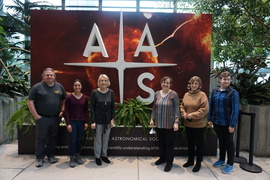The Sharpless CHARcuterie Playground (SCHARP) team will be studying several targets selected from the Sharpless (1959) catalog to see if there are young stars therein.
We propose to use archival data to search for and identify candidate young stellar objects (YSOs) in selected Sharpless Catalog regions. Stuart Sharpless identified and cataloged 313 H II regions in the entire sky north of declination -27° (Sharpless, 1959). Many of those HII regions are well known star forming regions, already studied extensively using multiwavelength data. Of these 313 regions, we identified about 60 Sharpless regions that have not yet been mined for YSOs using infrared (IR) and optical data but look like they might harbor YSOs. We noticed patterns in the target list: (a) targets where there was obvious IR nebulosity and likely YSOs; (b) targets with small, largely circular clumps of blue stars; (c) dispersed red stars. We plan to analyze 5 regions encompassing 8 Sharpless targets distributed over these groups to look for YSO candidates. We also have a “control” target that does not appear like any of those regions so that we can use it as a comparison but is still a Sharpless catalog object. To identify candidate YSOs, we will collect and combine the catalogs across wavelengths (bandmerge) archival infrared and optical survey data from multiple catalogs. We will construct color-color and color-magnitude diagrams to select YSO candidates, inspect images, and build spectral energy distributions (SEDs) for each candidate. We will compare the “yield” of YSOs across the different types of regions, and see which type is more likely to harbor YSO candidates.
Caltech, Pasadena, California
Braswell High School, Aubrey, Texas Lake Dallas Middle School, Lake Dallas, Texas North Greene High School, Greeneville, Tennessee
La Jolla High School, La Jolla, California San Diego Unified School District, San Diego, California
WVU's HSTA program/Wheeling Park High School, Wheeling, West Virginia
The Shipley School, Bryn Mawr, Pennsylvania
Many people helped with the review of the 2023 NITARP teams' proposals. Thanks to you all! People at IPAC who helped included:
